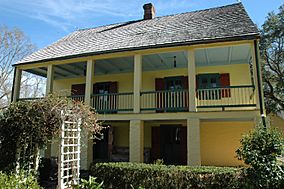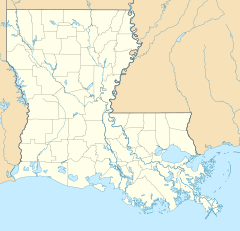Longfellow-Evangeline State Historic Site facts for kids
Quick facts for kids Longfellow-Evangeline State Historic Site |
|
|---|---|

Maison Olivier
|
|
| Location | St. Martin Parish, Louisiana, United States of America |
| Area | approx. 157 acres (64 ha) |
| Established | 1934 |
| Governing body | Louisiana Office of State Parks |
| Official web site: https://www.lastateparks.com/historic-sites/longfellow-evangeline-state-historic-site | |
|
Acadian House
|
|
| Built | c. 1815 |
| NRHP reference No. | 73002133 |
| Significant dates | |
| Added to NRHP | March 30, 1973 |
| Designated NHL | May 30, 1974 |
The Longfellow-Evangeline State Historic Site is a special place in St. Martinville, Louisiana. It helps us learn about the important history and culture of the Bayou Teche area. This site is the oldest state park in Louisiana, first opened in 1934.
The park is named after Evangeline, a very famous poem from 1847 by Henry Wadsworth Longfellow. This poem tells the story of Acadian sweethearts, Evangeline and Gabriel, who are now part of local legends. In the town, the Evangeline Oak is said to be where the two lovers met. A statue of Evangeline marks her supposed grave near St. Martin of Tours Church. The historic site helps us remember the history of the Acadian and Creole people in this part of Louisiana, which is what the poem is about.
Contents
Exploring Historic Buildings
The Longfellow-Evangeline State Historic Site covers about 157 acres. It features several old buildings that show how people lived long ago.
Maison Olivier: A Creole Home
Maison Olivier, also known as the Acadian House, became a special National Historic Landmark in 1974. This large home was built around 1815 by Pierre Olivier Duclozel de Vezin, who was a rich Creole person.
Unique Architecture of Maison Olivier
Maison Olivier is a great example of a "Raised Creole Cottage." This type of house has a unique style. It mixes ideas from Creole, Caribbean, and French building designs. You can find Maison Olivier behind the visitor center. There is also an old blacksmith shop nearby.
Acadian Cabin: A Glimpse into the Past
The site also has an Acadian cabin from about 1790. This cabin shows how different Acadian homes were from Creole homes. It helps visitors understand the simple life of early Acadian settlers.
Acadian Farmstead: Life in the 1800s
Near Bayou Teche, there is a recreated Acadian farm. It looks like a typical family farm from the early 1800s. This farm includes a family house, a barn, an outdoor toilet (called a privy), an outdoor kitchen, and a special oven for baking bread. It gives a good idea of daily life on a farm back then.


